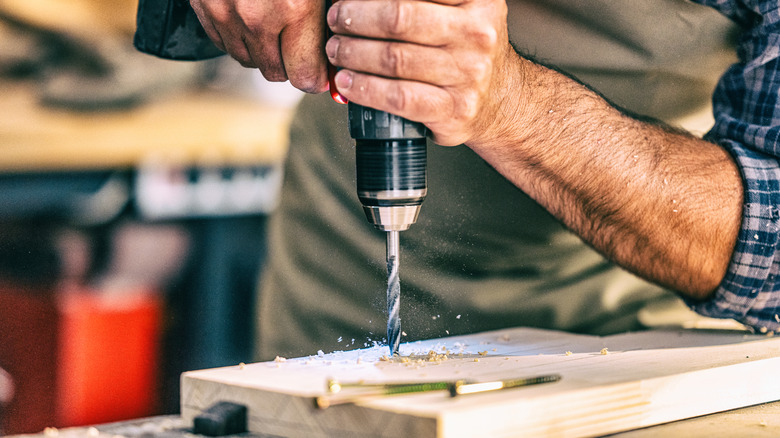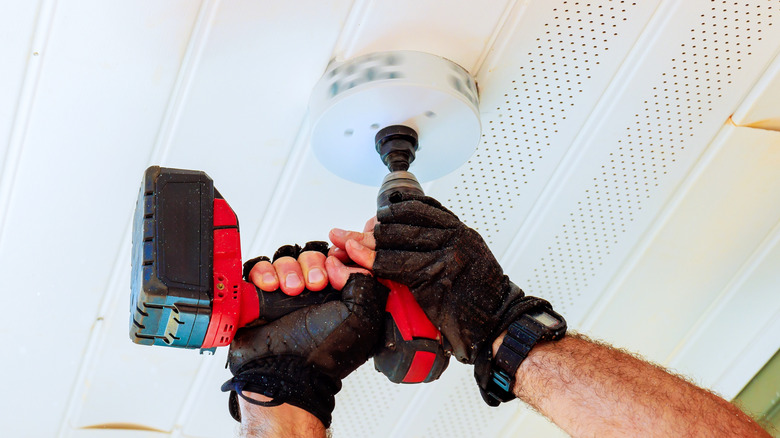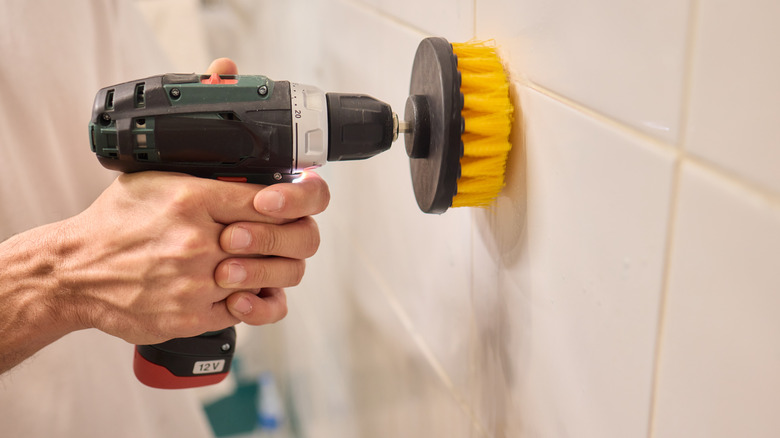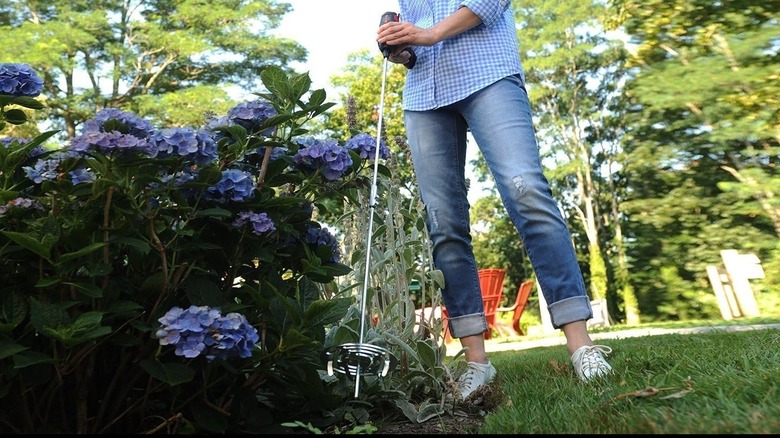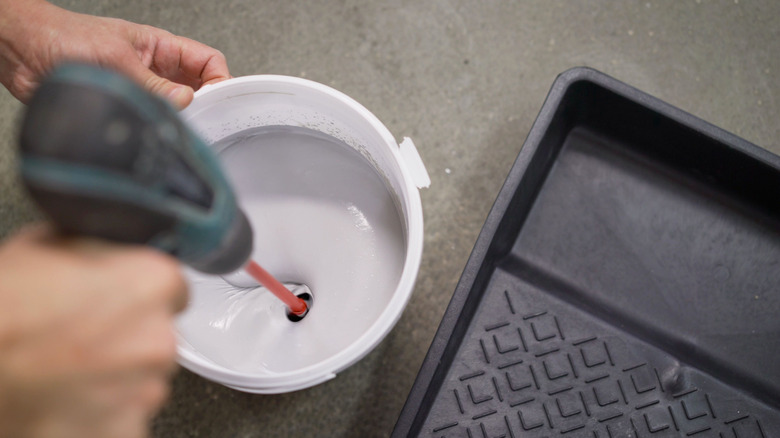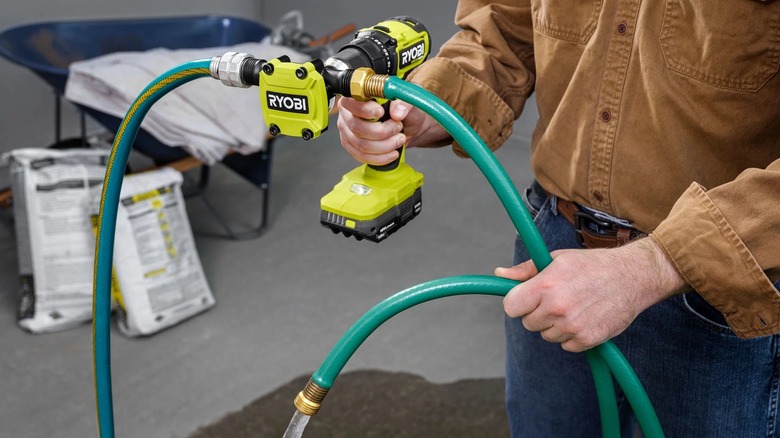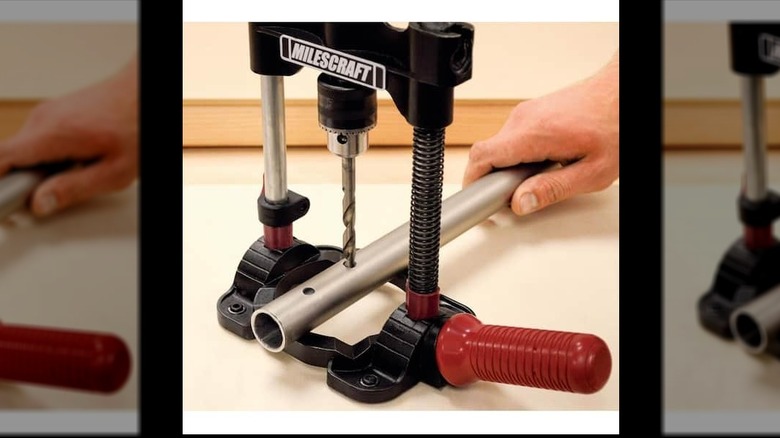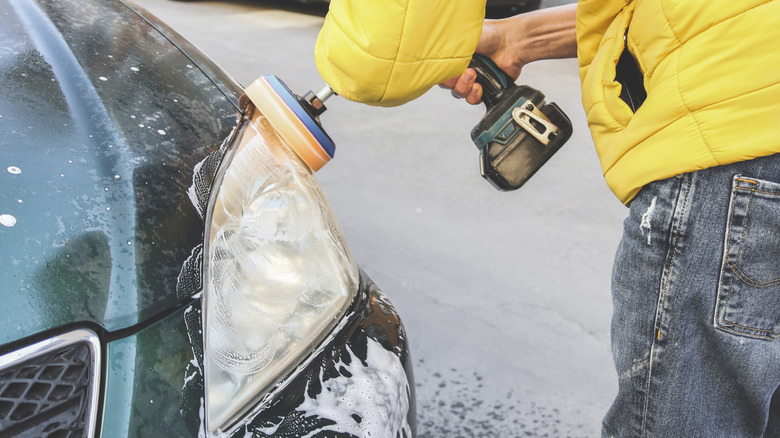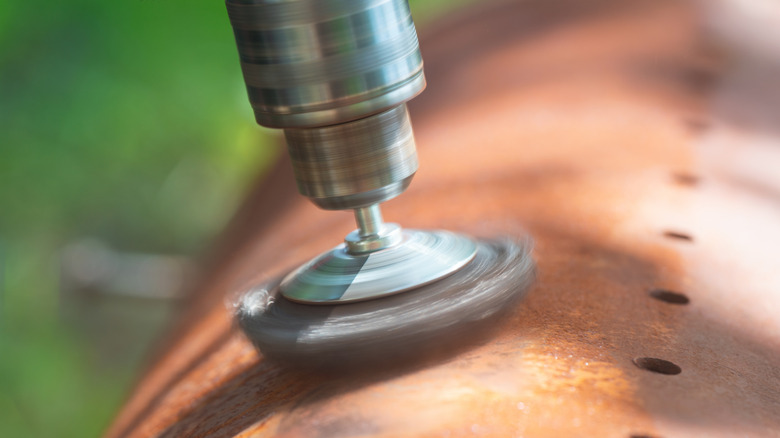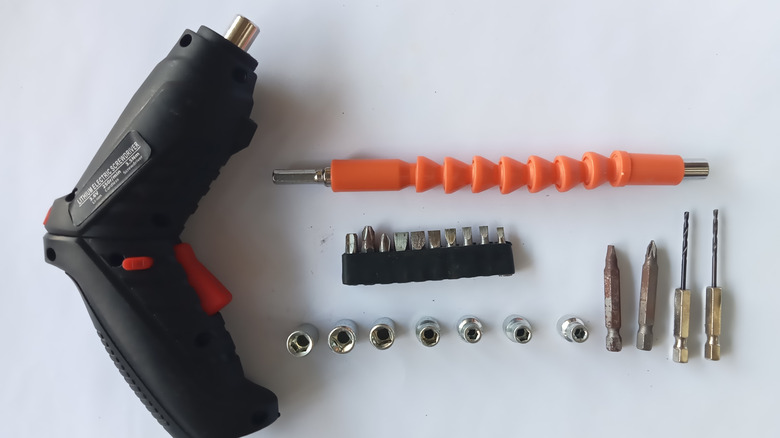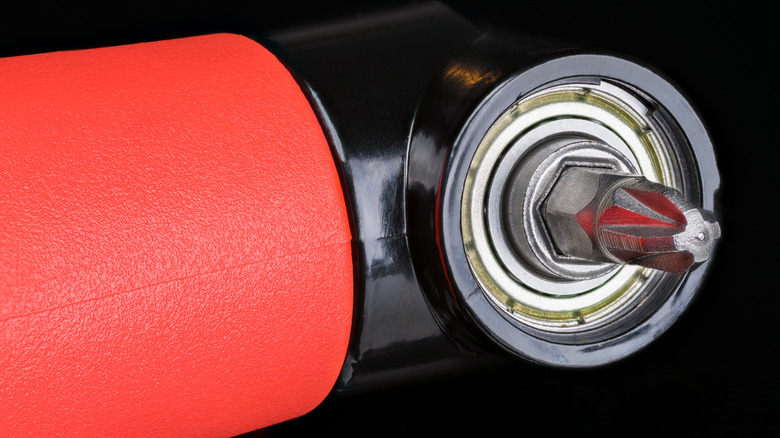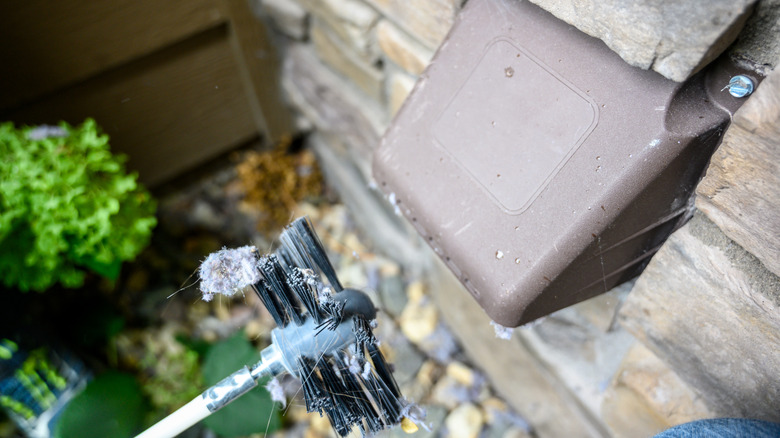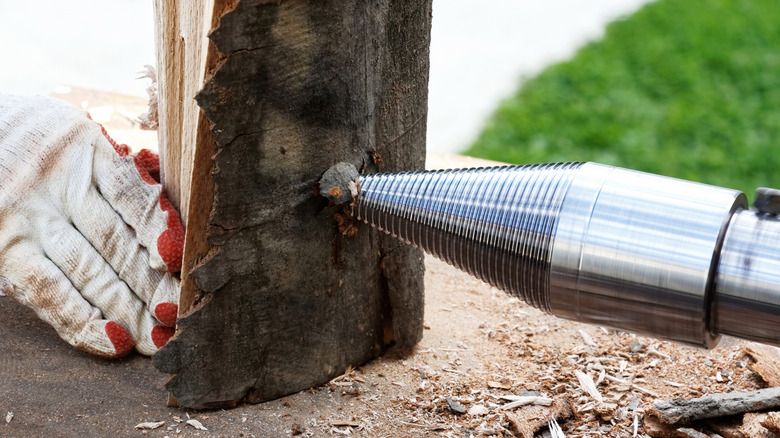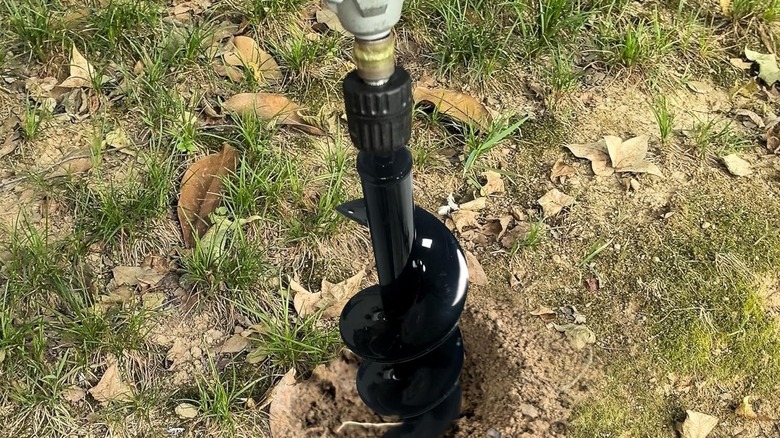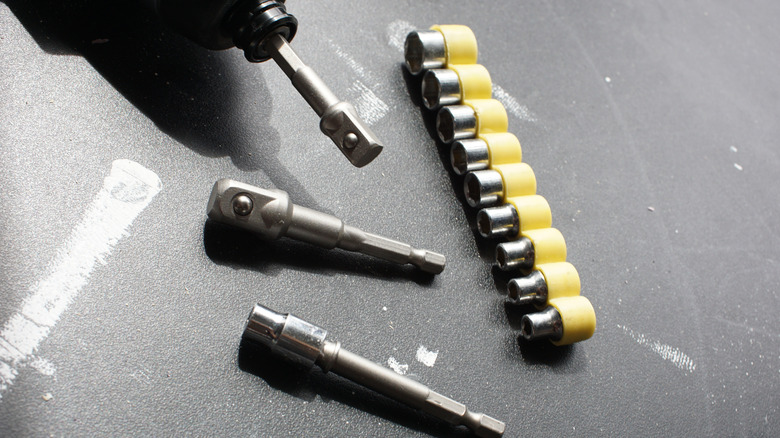16 Handy Drill Attachments You'll Wish You Bought Sooner
We may receive a commission on purchases made from links.
For many homeowners, a good power drill is a trusty sidekick for all of those household maintenance tasks and DIY projects. It's one of many must-buy power tools for first-time homebuyers and experienced homeowners alike. But this common power tool isn't limited to just drilling holes with standard drill bits. The sheer number of drill attachments and specialty bits available might surprise you. Attachments like hole saws, scrub brushes, kindling splitters, dryer vent cleaning kits, and paint mixers transform your drill into other tools, which saves you money and space. Other drill attachments, including drill guides, right-angle attachments, and flexible shaft bit holders, support your use of regular drill bits, helping you reach difficult spots or drill at an angle.
While there are many useful drill attachments, you might not need them all. If you have no plans to drill into brick or glass, you don't need the specialty bits that allow you to safely make those holes. Condo owners without outdoor gardening space won't find tiller or auger attachments useful. Evaluate the following helpful attachments carefully to determine if you actually have a use for them. If you plan to stock up on several attachments, it may be worth it to splurge on a quality cordless drill that can handle the heavy workload.
Hole saw attachments to cut perfect larger circles
Some projects call for circular cuts that aren't easy to make manually with a saw. That's where the hole saw attachment comes in handy. It's a circular attachment that goes onto the chuck of your drill. The middle of the attachment is hollow, and the edges have saw-like teeth to cut through various materials. The pilot bit in the center of the hole saw offers stability to ensure the holes you cut are round. Hole saws are used when you need larger circles cut (with different sizes available), and they cut out a circular center core of drywall, wood, or whatever material you are working with.
As a homeowner, you might need to cut perfect circles through materials. For example, you might need to cut a circle in the ceiling for a light fixture or in a door for a handle. That hole needs to be a neat circle to keep the finished project tidy. Round holes are also handy for running ventilation, plumbing lines, electrical wiring, and cords for various home systems, so if you're tackling any of these jobs on your own, this drill attachment can be worthwhile.
Sanding kits to smooth surfaces quickly
Sandpaper and sanding blocks are effective for small projects, but having a powered sander makes the job much faster and easier. However, you don't have to buy specialty power sanding tools that will take up more space (and likely not get used very often). Instead, buy smaller sanding attachments for the drill you already own. They come in different formats, including flap sanding wheels, drums and sleeves, and discs. You can choose from a range of sizes and grit levels to match your project. The drill causes the sanding attachment to spin quickly to smooth the surface of various materials.
This drill attachment is a good option for light to medium sanding jobs — dedicated, heavy-duty sanding equipment is better for more intense sanding applications. Choose the sanding attachment that matches your project. For example, sanding drums work well for smoothing edges or rounded surfaces, while flap sanding wheels (sometimes called molding flap wheels) are better for irregular shapes and raised panels.
Cleaning attachments for extra scrubbing power
Powered scrubbers are advertised all over the place right now. Who doesn't want to cut cleaning time and use less muscle to scour away grime? But you don't need a separate power scrubber — you just need special attachments that turn your drill into a powered cleaning brush or scrubber. Cleaning attachments are one of many genius cleaning tools you absolutely need for your home. The motion from the drill makes the cleaning attachments more powerful than using scrub brushes or scouring pads by hand.
Brushes and scrub pads are the two main types of attachments, but you'll find variations in each. Many sets, like this Tialero Drill Brush Attachment Set, come with multiple brush styles, including flat round and dome-shaped brushes. Scrubbing pads, like the Swpeet Pads, often come in different grits, with softer options for shower glass and tougher versions for sturdy surfaces. Choose an appropriate attachment for the surface to prevent scratches or damage.
Drill-powered tiller to cultivate your garden
Your drill probably isn't the first tool you think of when you prepare to garden (unless you're starting a raised bed garden and want to build the beds yourself). But it can be an ideal gardening tool when you add a cultivator attachment, like the DrillTill or the Fusion Drill-Powered Cultivator. These tools have tiller heads that work the soil, using the rotational power of your drill. The depth to which they drill varies, ranging from about an inch to about 5 inches deep.
A drill cultivator attachment won't be as large or powerful as a stand-alone tiller, so it's best for smaller garden areas or raised beds that are already established. Use it to aerate, weed, or mix the soil in your established bed. Keep in mind that you may need to stop to recharge the drill battery, so larger areas could take longer to complete.
Paint mixer for consistent color
Stirring attachments come in a wide range of shapes, from paddles to random shapes with multiple flexible arms coming out from the middle. Some models are flexible enough to squeeze through the pour spout hole that's usually on 5-gallon buckets of paint or other finishes. On the opposite end, the mixer features a hex shank that secures into the chuck of your drill.
No matter how long the attachment is or what the shape of the end is, they work similarly — the rotation of the drill turns the head, which helps mix paints, finishes, grout, and other similar materials. The result is a consistent product that gives you better results during home improvement projects. Grab this attachment if you're planning tiling, painting, or floor refinishing projects. It's an inexpensive attachment with many options. For example, the Edward Tool Paint Mixer Drill Attachment is available for under $10. It's also a small attachment that won't take up more storage space, but it'll save your muscles when you need to stir products.
Drill-powered water pump to move water quickly
Need help moving water from one place to another or draining it from an area where it doesn't belong? Put away the bucket — with a water pump attachment (like the Ryobi Hex Shank Drill Pump), your drill powers the water transfer to make it faster and easier. It's a small attachment that typically has a standard garden hose connection to help move the water. The pump is designed to keep the moisture away from your drill to prevent any water damage to the tool. Water transfer rates can vary based on the model — the Ryobi pump version transfers water at rate of up to 10 gallons per minute.
This drill-powered pump has applications inside the house and outdoors in the garden. Use it to drain a small pool, tank, or outdoor water feature quickly. If you have an RV, you can use the pump to help empty the water tank. Inside the home, this pump comes in handy if you have a plumbing issue and need to remove the water from your tub, washing machine, or another indoor area. It also comes in handy if you have a large fish tank you need to empty.
Drill guides to create consistent angles
When precision in your drilling matters, it's helpful to have a guide. In this case, it's the Milescraft DrillMate Drilling Guide. It attaches to most ⅜ inch and ½ inch drills for a sturdy and reliable guide when drilling. The guide works for straight holes, but perhaps more beneficial is the ability to set it to an angle between 45 and 90 degrees. This particular model also features a base that prevents slipping, making it ideal when you're drilling through rounded pieces. You can use the guide along with many different types of drill bits, making it a versatile option for most projects.
Occasional use of a power drill to hang artwork or make basic holes probably doesn't require a guide. However, if you enjoy woodworking or have projects that rely on accuracy, this guide could be a worthwhile addition to your drill attachment collection. It's also helpful if you regularly drill at an angle, which can be challenging without a guide.
Buffing and polishing attachments for at-home shine
Whether you want to detail your car at home or make your kitchen sink shine, buffing and polishing attachments make the job easier. You can get a smooth, polished finish with little effort compared to hand buffing or polishing. They come in a range of types and textures, from soft to firm, to work on different materials. The drill rotates the pads, handling the polishing and buffing work for you.
Add this attachment to your collection if you like to wash and maintain your vehicles at home. They're also useful for polishing various surfaces around your home, including stainless steel. When using polishing or buffing pads, make sure you choose the appropriate type. Cutting pads will remove more of the surface and are used for getting rid of scratches or other marks — they could cause damage if you're really just looking for a little shine. Finishing pads are gentler and provide a glossy look.
Wire brush attachments to remove rust and paint
Tough jobs, like removing layers of paint or rust, call from durable, effective tools. Instead of reaching for chemical remover or scrubbing surfaces by hand, consider a write brush attachment for your drill. Wire brush attachments are usually round with a steel-wool-like texture. When attached to a drill, they rotate quickly, removing tough debris, like glue residue, rust, corrosion, and thick layers of paint.
You might want to grab a wire brush attachment if you have a major rust removal or paint removal job to handle. It can also come in handy if you're planning welding work — the wire brush helps deburr metal edges and blend edges. A wire brush attachment is also a clever tool for weathering wood for a more rustic look — it helps scrape up the wood surface, giving an aged effect. Keep in mind that the wire bristles spin quickly and are heavy-duty, so don't use them on light jobs that just need a simple sanding — you could quickly gouge or ruin the surface.
Flexible shaft bit holder for hard-to-reach spots
Power drills work great in open areas where you can position the tool just right. But some jobs require close quarters or difficult-to-reach spots where you can't hold the drill straight. The Ryobi Flexible Shaft Bit Holder (or similar drill attachments) make it easier to tackle those jobs. Available in different lengths, these extension pieces flex and bend in different directions, allowing you to reach inner corners and other tight areas.
Homeowners who use their drills frequently may benefit from this attachment. It's a relatively inexpensive item and is small, so it won't take up much storage room. It can be helpful to reach inside of cabinets or drawers and can also be helpful for plumbing repairs, woodworking, or automotive tasks. It's best to only bend the extension as much as necessary to reach the area, and move slowly with the drill to maintain control.
Right-angle attachments for tight spots
Another solution for reaching difficult or tight spots is a right-angle drill attachment. Instead of using a long, flexible extension piece, this attachment is a shorter piece that's fixed at a right angle — the compact size makes it easier for the attachment to work in small spaces. The piece attaches to the chuck of a standard power drill, so you can reach around corners to use the drill.
You might benefit from this type of drill attachment if you frequently do repairs or home improvement projects. It's a more affordable alternative to a right-angle drill, which has a head that's permanently positioned at 90 degrees. If you only need this type of positioning occasionally, the attachment is suitable for your tool set. The right-angle attachment helps you reach inside cabinets, around corners, between joists, and in other tight areas where you can't hold the drill straight.
Dryer duct cleaner to clear lint
Did you know there's a drill attachment that offers an effective cleaning method for your dryer vent? The brush-like attachment usually comes with multiple rods, which allow you to adjust the length of the vent cleaner. This Holikme Dryer Vent Cleaner Kit includes up to 40 feet of length, while other sets offer shorter lengths to make the length of your vent. When the brush and rods are attached to a drill, they rotate as they move through the vent, helping to remove debris from the inside.
Anyone who has a ventilated dryer in their home will benefit from the dryer vent cleaner attachment. Even if you clean your lint trap regularly, it's still possible for lint to get stuck in the vent, where the flammable material can limit airflow, interfere with proper exhausting efforts, and even cause a fire. You can have the vents professionally cleaned, but using a drill attachment brush is a more affordable alternative for mild to moderate blockages. Medium to high speeds work best for removing the lint completely.
Kindling firewood splitter to prep firewood quickly
From the warmth and glow of a wood-burning fireplace to a fun backyard bonfire, there's something special about wood-fueled flames. But preparing all of the firewood is a lot of work. Kindling prep becomes much easier with a splitter attachment for your drill. It's typically a cone-shaped attachment with grooves on it that's designed to split apart pieces of wood.
This attachment is handy for people who own a wood-burning fireplace, a wood stove, or a wood firepit. It's also a handy option to bring camping, so you can quickly prep kindling for your campfires. Keep in mind that this attachment is generally meant for kindling and smaller logs rather than large pieces of wood, so you may need a larger splitting tool if you prep large amounts of wood. To use the attachment, start the drill on the lowest speed, and work with the grain of the wood to make it split easily. Be careful to keep your hands clear of the attachment when splitting the wood.
Hole digger attachment for plant or post holes
Tired of digging holes with shovels — and all the muscle that it requires? An auger or hole digging drill attachment cuts the workload significantly. It's a much larger attachment than some of the others on this list, and has a spiral design that smoothly moves dirt aside, creating a small hole in the ground. The end attaches to the chuck on your drill, and the rotating power of the drill spins the auger, helping it push aside the dirt. Some versions come in different diameters, allowing you to customize the size of holes you dig.
Gardeners will appreciate this unique drill attachment — it will create perfectly sized holes for all of your seedlings or items you transplant. Using the attachment could be particularly helpful in large gardens where you're digging lots of holes. You can also use it to create holes for small fence poles, supports, or other structures in your yard.
Socket adapter set to drive nuts and bolts
Pair your socket set with your power drill using a socket adapter set. It allows you to attach sockets securely to your drill or impact driver. One end of the adapter fits into the drill's chuck, while the other end has a square drive that holds your sockets tightly.
With this adapter, you can put down the ratchet and stop tightening nuts and bolts by hand. The power of the impact driver or power drill turns nuts, bolts, and screws with external hex heads. It makes the work easier and faster, which can come in handy if you're dealing with a large number of fasteners or if your grip strength makes it difficult to drive the fasteners manually. The socket end of the adapter can come in different sizes, such as ¼ inch or ⅜ inch, so check the size to make sure it's compatible.
Masonry or glass drill bits for specialty projects
There are many common mistakes when using a cordless drill — using the wrong drill bit is one. That's why you don't want to reach for any old drill bit when you need to make a hole in concrete, brick, stone, glass, or other fragile materials. Masonry bits typically have tungsten or carbide tips with a steel shank. There are different types, including SDS bits, which are compatible with hammer drills. For drilling glass or tile, diamond-tipped and carbide-tipped bits are the main options, with diamond bits offering greater durability. Glass bits usually have a spear-shaped tip rather than a flat or spade-shaped end.
You might need a masonry drill bit if you have exposed brick walls in your home — the specialty tip will make it much easier to hang decor without damaging the walls. Outdoors, these bits are useful if you need to drill into parts of your home's exterior that are masonry or for garden projects, like garden beds build with concrete blocks. Glass drill bits are useful if you're drilling into tile or other glass surfaces — this could be the case if you're installing a grab bar or shelf in a bathroom.
